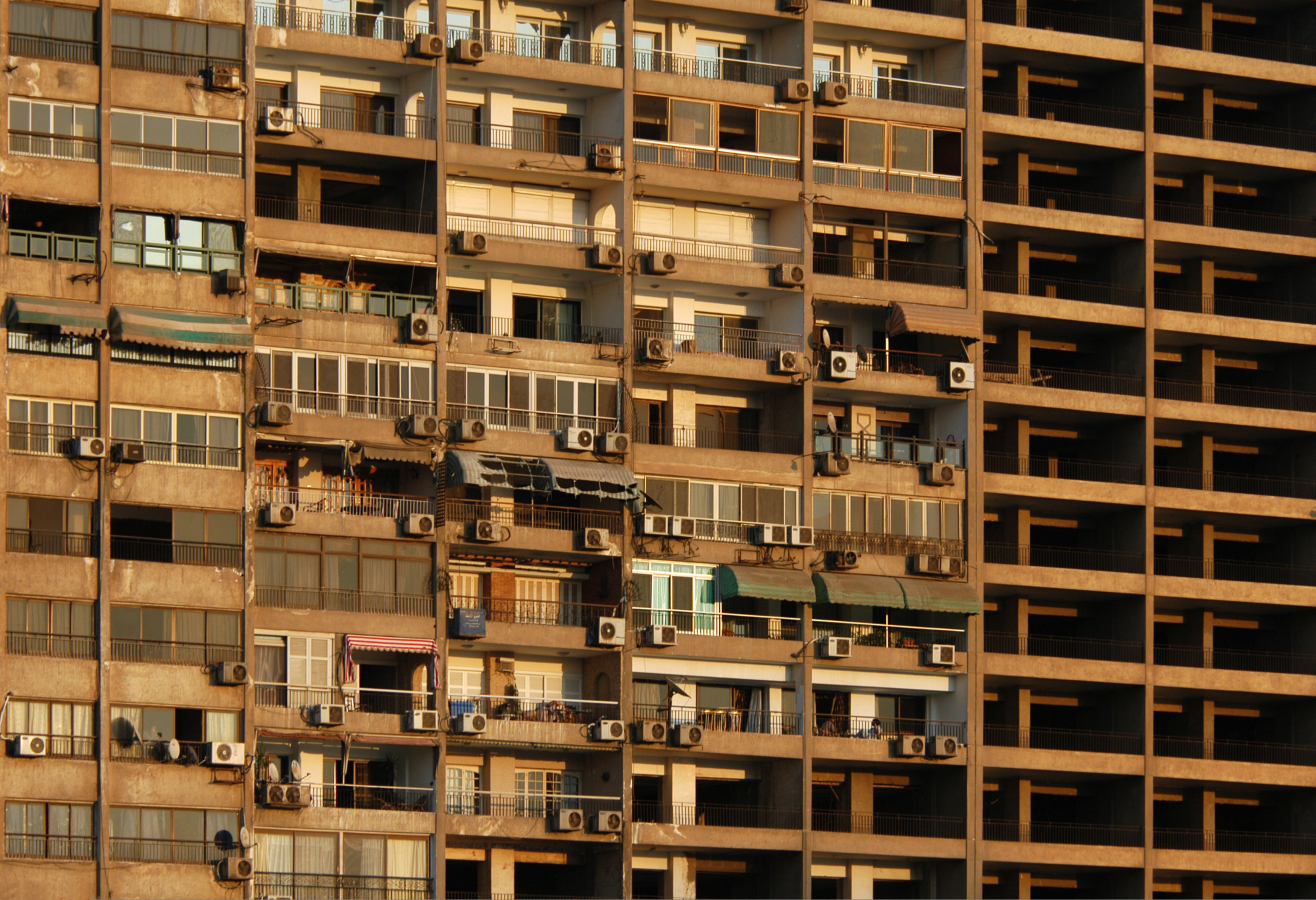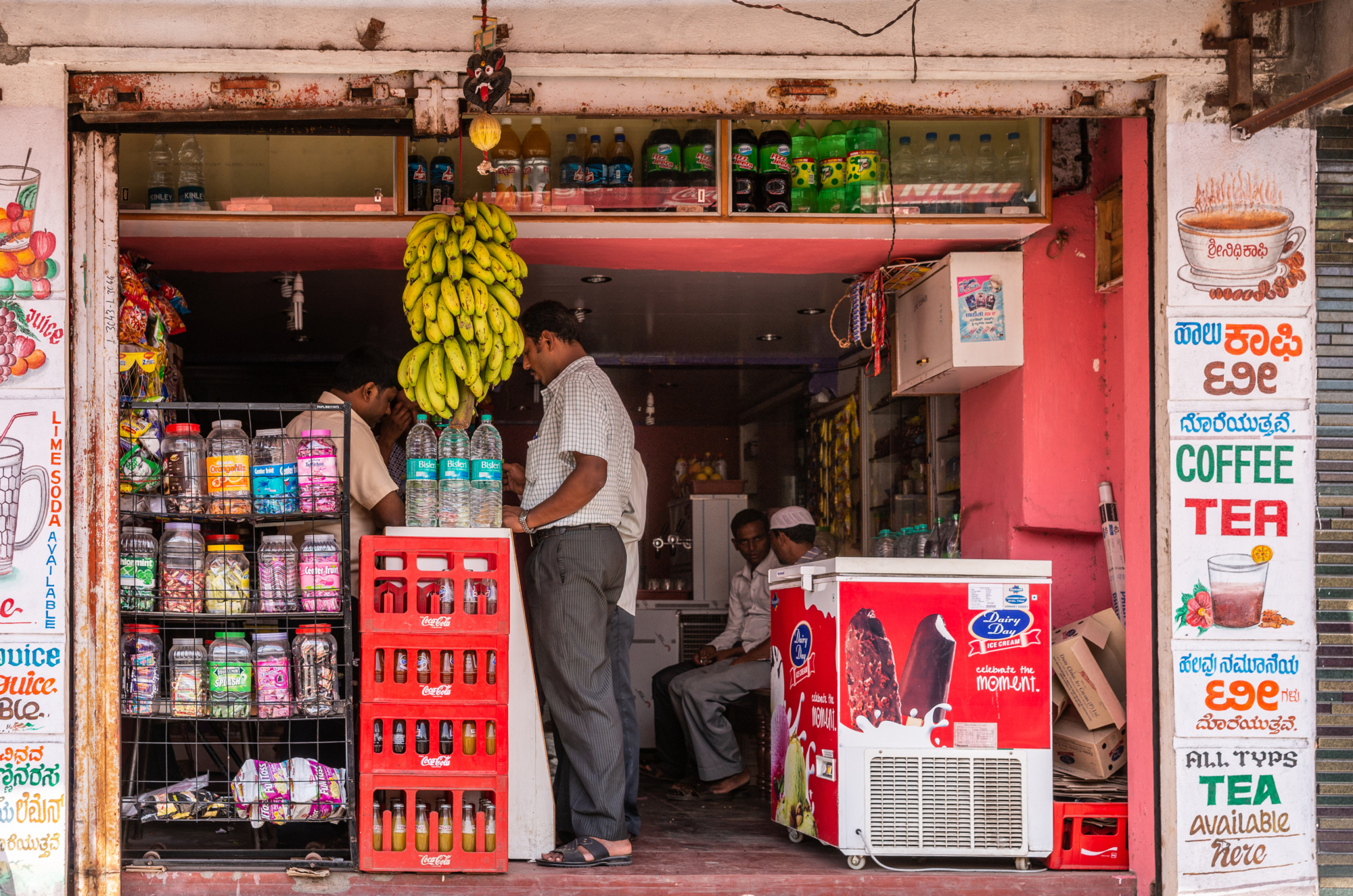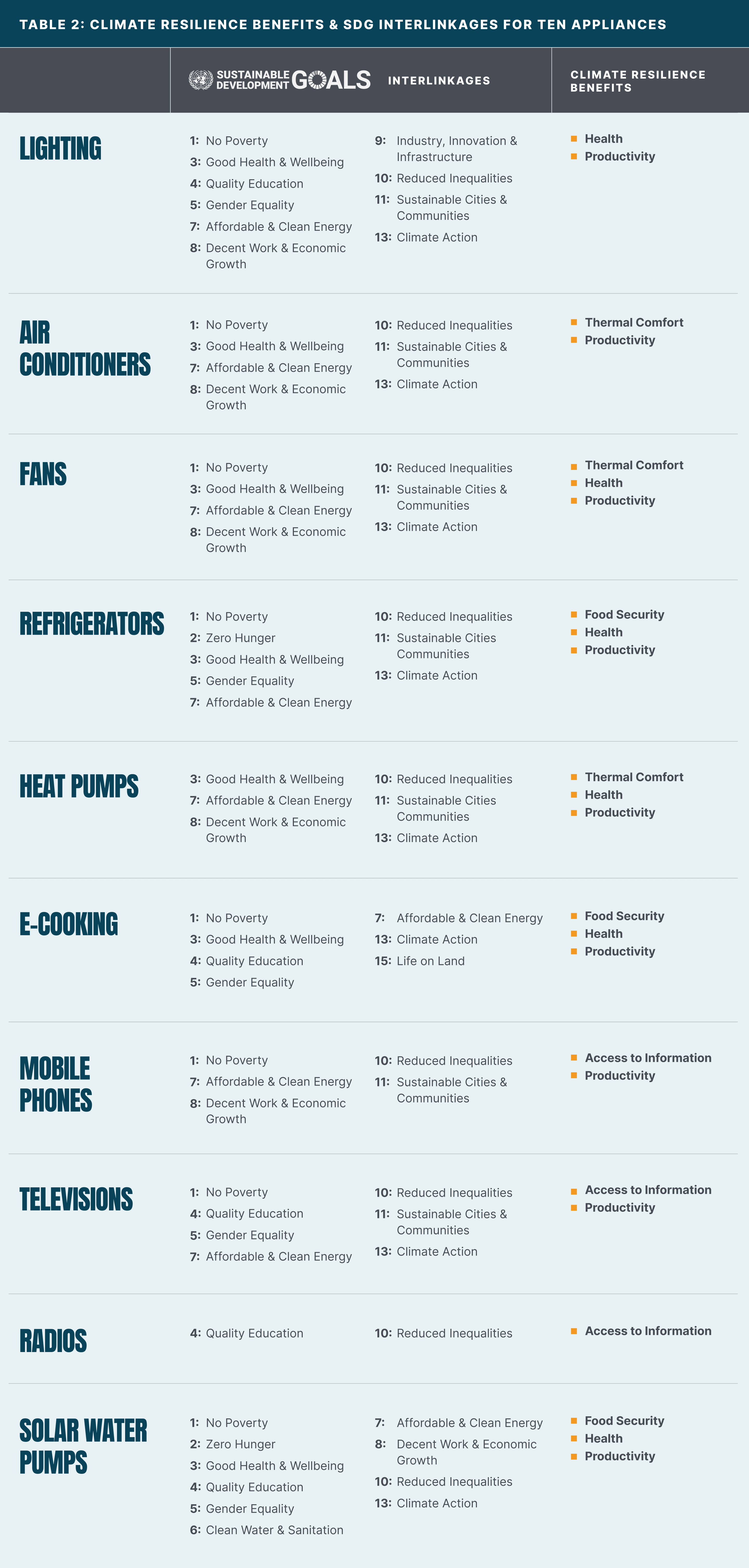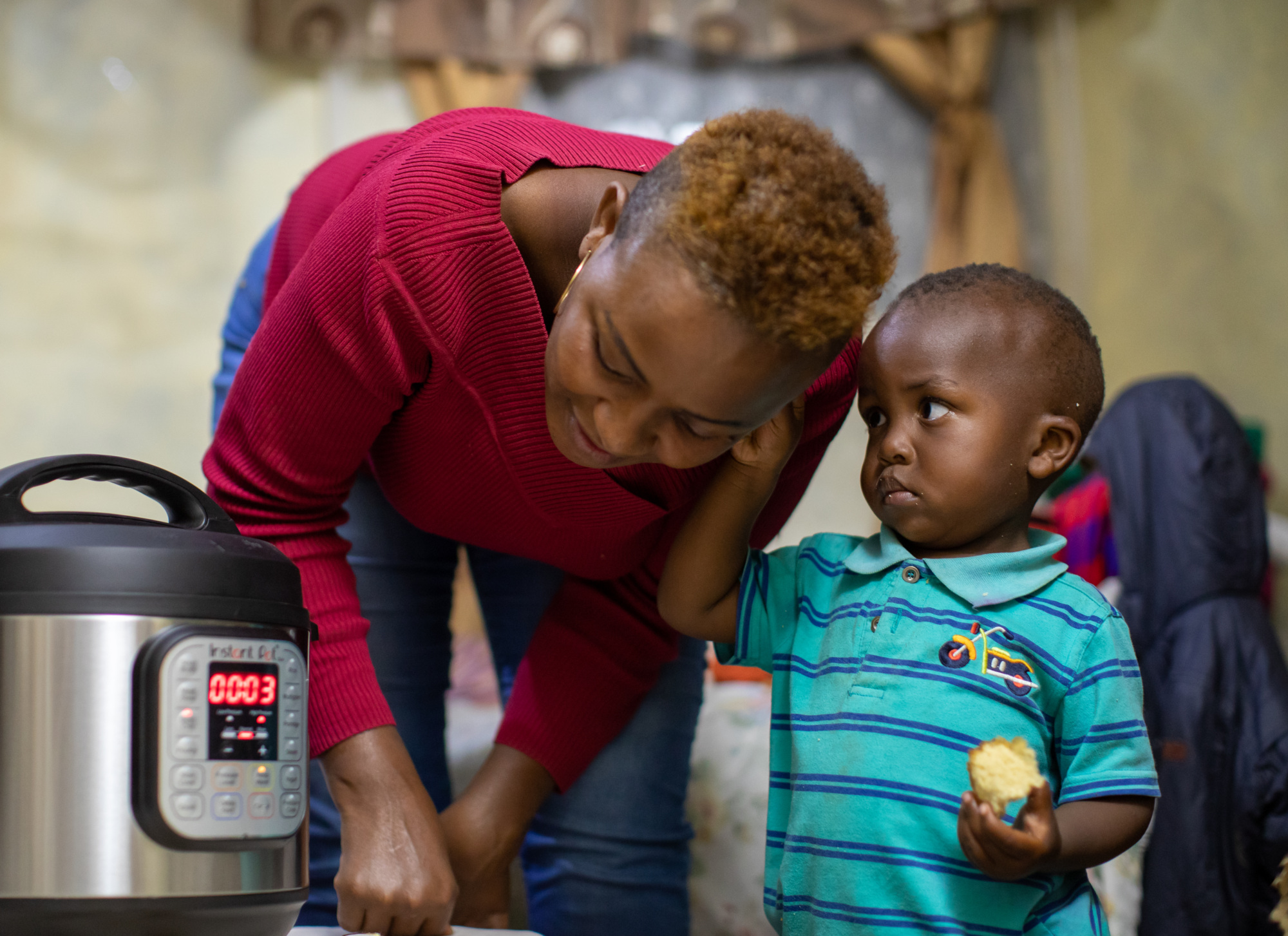01 Appliances: Impacts and Benefits
The Paris Agreement presents nations with a dual mandate to decarbonize their economies and help vulnerable groups adapt to a changing climate. Recognizing this need, the Intergovernmental Panel on Climate Change (IPCC) has advocated for a climate-resilient development approach that integrates adaptation measures and their enabling conditions with mitigation to advance sustainable development for all.1
Appliances are at the nexus of mitigation, adaptation, and resilience. They form a larger part of the solution to climate change than many realize. In fact, higher efficiency appliances are essential to achieving the goals of the Paris Agreement and promoting climate-resilient development.
Appliances are at the nexus of climate change mitigation, adaptation, and resilience.
Appliances are responsible for 39% of all energy-related CO2 emissions. We cannot achieve NZE without significantly improving appliance energy efficiency. Tens of billions of appliances are in use today,2 all of which consume electricity or burn fuel, emit other pollutants, or result in further energy use and pollution during manufacture. This number is growing.3 The resultant emissions and air pollution are already harming millions today and changing the world in ways that will impact future generations.4 Greenhouse gas (GHG) emissions and air pollution can be mitigated through efficiency (using less energy) and electrification (switching from direct fuel combustion to low-carbon electricity).
At the same time, as many as 3.6 billion people live in regions that are highly vulnerable to climate change.5 CLASP estimates that hundreds of millions to billions of people lack access to electricity and the appliances needed to cope with a warming world. Expanding access to efficient appliances must be an essential component of any climate-resilient development approach. From lifesaving cooling services to communication devices that provide vital lifelines to information and business opportunities, efficient appliances empower people to live a quality life and build resilience to climate risks. Expanded access to these life-changing appliances provides an array of social, economic, and other benefits to households that further bolster community resilience, adaptive capacity, and climate-resilient development. CLASP estimates that universal access to, or ownership of, ten essential appliances can help deliver 12 of the 17 United Nations (UN) Sustainable Development Goals (SDGs). An equitable, low-carbon, and climate-resilient future is not possible without universal appliance access.
This section makes the case for why efficient appliances must be elevated in the global climate dialogue. It is divided into two parts: the energy and GHG impacts of appliances globally and the climate adaptation, resilience, and sustainable development benefits of efficient appliances.

Section 1.1 begins with a review of appliance energy use and appliances’ contribution to climate change. We analyze the GHG emissions from burning fossil fuels to generate that energy. When referring to appliances’ climate mitigation potential, we focus on appliances used in residential and commercial buildings (encompassing all appliances, heating and cooling systems, and lighting used in homes and buildings, but not the electricity used to charge electric vehicles) as well as the electric motor-driven systems used in industry (encompassing industrial motors and their system components such as variable-speed drives, fans, pumps, and compressors). This total also includes emissions from biomass used in cooking and heating.
Appliances are also responsible for the release of other non-CO2 GHGs and short-lived climate pollutants. Limiting or eliminating the release of all appliance-related emissions is needed to halt climate change. However, when estimating the climate impact of appliances, CLASP’s analysis focuses solely on CO2 emissions and does not include non-CO2 GHG and short-lived climate pollutant emissions, or methane and refrigerant emissions from leakage. If we were to include these emissions in our analysis, appliances would have an even greater impact on global GHG emissions and warming. Part one concludes with a short description of these pollutants and their warming potential.
Section 1.2 provides an overview of the climate resilience, adaptation, and sustainable development benefits that appliances offer. It makes the case for why appliances should be a central component of any climate-resilient development approach by mapping ten appliances essential for building climate resilience (lighting, air conditioners, fans, refrigerators, heat pumps, e-cooking appliances, mobile phones, televisions, radios, and solar water pumps) to their climate resilience benefits and related SDGs. The set of appliances assessed in this analysis differs from the set of appliances used to estimate global energy demand and resulting CO2 impacts. In part two, we do not assess appliances and equipment used in commercial buildings or the industrial sector, nor do we assess residential water heating. CLASP recognizes that expanded access to efficient commercial appliances and equipment, like cold chain technology, is also essential to improving climate adaptation and resilience. However, our analysis focuses on residential appliances, highlighting the benefits to individual households. We expand the series of household appliances to include low energy-consuming appliances like radios, cell phones, and televisions, as well as household productive use appliances like solar water pumps. We include these appliances because they offer critical climate resilience or adaptation benefits.
Table 1. Summary of Appliances Included in Section 1
| Appliances essential to climate change mitigation | Appliances essential to climate resilience and sustainable development |
|---|---|
Section 1.1 evaluates the climate impact of the following residential, commercial, and industrial appliance categories:
|
Section 1.2 evaluates the resilience benefits of ten residential appliances:
|
1.1 Climate Impacts
Energy Use & Carbon Emissions
Appliances represent a large share of global final energy consumption and emissions. According to the IEA, the buildings sector accounted for 30% of total global final energy consumption in 2021.6 Industry accounted for more than one-third.7 But it is not the homes, offices, or factory buildings that are consuming the energy and emitting CO2 and other GHGs. It is the appliances inside those structures. These devices transform energy into useful work, providing essential services, enabling communication and entertainment, saving labor, contributing to livelihoods and wellbeing, and powering industrial processes at all scales. Demand for these services is growing, particularly in emerging economies.
To estimate the total climate impact of the appliances sector, CLASP has combined emissions from:
- residential and commercial buildings (encompassing all appliances, heating and cooling systems, and lighting, but not electric vehicles)
- the electric motor-driven systems used in industry (encompassing industrial motors and their system components, such as variable-speed drives, fans, pumps, and compressors)
- biomass used in cooking and heating

CLASP’s analysis finds that appliances accounted for 35% of global energy demand8 and nearly 40% of global energy-related CO2 emissions in 2021. These emissions come either from the direct combustion of fossil fuels that are delivered to the building or indirectly from electricity. While the share of electricity generated from renewable and other emissions-free sources is growing, historically, fossil fuels comprised approximately 80% of the global generation mix.9 This estimate does not include emissions from methane or refrigerant leakage, which are discussed later in this section.
The resultant fuel-related emissions—both due to on-site combustion and off-site electricity generation—totaled 14 Gt CO2, or 39% of the global total, in 2021. Figure 1 puts these emissions in the context of all sources of energy-related emissions.
Figure 1. Global Share of Total Energy-Related CO2 Emissions by Sector (2021)10
IEA further breaks down the energy use of appliances into end-use or major functional categories. Figure 2 shows the energy breakdowns for 2020, the most recent year for which detailed data are available. Emissions breakdowns for the individual end-uses were not available.
Figure 2. Appliance Final Energy Consumption by End Use (2020)11
Space heating is the largest energy user by far, although the load from air conditioning is growing due to rising incomes in countries with hot and humid climates paired with more extreme and frequent heat waves everywhere. Past IEA analyses have estimated that space-cooling loads could grow nearly threefold from 1.5 billion air conditioners today to 4.4 billion by 2050.12 Also of note is energy use for cooking. Globally, around 2.4 billion people13 still cook using traditional solid fuels,14 leading to significant health and global warming impacts.
![]() Case Study: Appliance efficiency standards can curb energy from cooling appliances. China’s world-leading AC MEPS have helped to eliminate 70% of the most inefficient models from the market and are expected to avoid 2,322 Mt of CO2 emissions cumulatively through 2030. Read the full case study, Revolutionizing Cooling and Climate: China’s Pioneering AC Efficiency Standards.
Case Study: Appliance efficiency standards can curb energy from cooling appliances. China’s world-leading AC MEPS have helped to eliminate 70% of the most inefficient models from the market and are expected to avoid 2,322 Mt of CO2 emissions cumulatively through 2030. Read the full case study, Revolutionizing Cooling and Climate: China’s Pioneering AC Efficiency Standards.
Other Greenhouse Gas Emissions
Fuel Combustion Emissions
CLASP’s analysis does not quantify non-CO2 GHG emissions from direct use for the appliances sector, nor does it estimate the climate impact of methane and refrigerant leaks. Meeting our Net Zero Hero targets for the appliance sector, outlined in Section 3, would yield reductions in important GHG and short-lived climate pollutants like nitrous oxide (N2O) and black carbon. These climate pollutants have significant warming potential and also contribute to poor air quality, harming human health.
Methane (CH4) and N2O are also emitted during fuel combustion, but in quantities that are four to six orders of magnitude smaller than CO2. So, despite these other gasses’ high global warming potential (GWP) compared to CO2, their absolute impact from combustion is minuscule.15,16 They are, therefore, usually ignored in impact analyses.
The one pollutant of note with a large GWP is black carbon. Black carbon is not a gas, but a particulate emitted during incomplete combustion of solid fuels—such as coal or biomass. Black carbon is the second largest contributor to global warming after CO2.17 Eliminating black carbon and its associated GWP is yet another benefit of transitioning from traditional biomass, coal, and kerosene to clean cooking and light emitting diode (LED) lighting.
Emissions from Leaks
Energy demand alone does not tell the complete climate impact story of the appliance sector. Fossil fuel appliances and heat pumping appliances (mainly air conditioners, heat pumps, and refrigeration) can also release methane and refrigerants into the atmosphere directly through leaks in the equipment itself, or through leaks in pipes and distribution networks, and fuel extraction and processing in the case of fossil fuel appliances. These leaks can have significant climate impacts. Methane has 82-87 times the GWP of CO2,18,19 while many refrigerants used today have a GWP hundreds or thousands of times that of CO2.20,21
CLASP’s analysis did not quantify the climate impacts from methane or refrigerant leaks when estimating the total emissions from the appliances sector. Additional information about their climate impacts is presented below.
Methane (natural) gas was previously proposed as a “bridge fuel” and a cleaner alternative to coal for space heating and electricity generation, as well as an alternative to coal and traditional biomass for cooking. The availability of cheap methane gas extracted through hydraulic fracturing (“fracking”), drove a sizable decrease in grid emissions in the United States (US). China, India, and Indonesia implemented large-scale campaigns to effectively transition most of their population from coal to liquefied petroleum gas (LPG) or methane gas stoves.
While the health and global warming impacts of methane combustion are smaller than those of coal or traditional biomass, significant amounts of methane leak into the atmosphere during extraction, distribution, and use. Estimates of methane leakage in the US range from 1.4%22 to 4.7%23 of total consumption. Methane has 82-87 times the GWP of CO2.24,25 Once realistic leakage estimates are factored in, the climate impacts of methane-fueled appliances double compared to combustion alone.26 As there remains some controversy regarding the amount of leakage, we have excluded both methane and refrigerant leakage from our estimates of total emissions from the appliances sector, resulting in a more conservative estimate.

While efficiency reduces energy consumption and the associated direct and indirect CO2 emissions, methane leakage also occurs upstream of the appliance. The primary way to eliminate methane leakage from the appliance sector is to transition from gas to electricity and decommission the gas distribution system. In the case of space heating, water heating, and clothes drying, that transition will rely largely on heat pumps—a technology that collects heat from ambient air, concentrates it, and then brings it inside a conditioned space, such as a building, water tank, or dryer drum.
Air conditioners, refrigerators, and heat pumps all use refrigerants to transfer heat between conditioned and unconditioned spaces. Many refrigerants used today have a GWP hundreds or thousands of times greater than CO2.27 As with gas infrastructure, leakage can also be an issue for heat pumping technologies.
The impact of refrigerant leakage depends on a number of factors, including the type of refrigerant used, charge size, typical leakage from piping, equipment maintenance, and recycling rate at the end of life. Larger systems, such as those used in commercial refrigeration, require more refrigerant and often have long pipe runs between the cabinet and the outdoor unit, with more opportunities for leakage. In contrast, many of the heat pumps used in homes, such as those used in household refrigerators and freezers, clothes dryers, and many water heaters, are self-contained and factory-sealed, minimizing leakage.
As with methane leakage, efficiency does not affect refrigerant leakage. Instead, to curb the impacts of leakage, policymakers will have to use policies to implement the Kigali Amendment to the Montreal Protocol on Substances that Deplete the Ozone Layer and require lower-GWP and natural refrigerants, quality installation, and refrigerant capture and recycling at end-of-life.
In summary, appliances account for a significant share of global greenhouse emissions. CLASP estimates that appliances are responsible for nearly 40% of all global energy-related CO2 emissions. If we were to account for other GHG emissions and emissions from leaks, appliances’ contribution to climate change would be even greater. It is therefore critical that governments prioritize appliance efficiency and electrification now in order to mitigate the negative environmental impacts of appliances.
1.2 Adaptation & Resilience Benefits
Section 1.1 identifies the negative climate impacts of energy inefficient appliances and equipment, highlighting the need for mitigation via more stringent policies and other measures. At the same time, there is a need to expand access to efficient appliances to the billions of people who currently lack access.
This section highlights the critical role appliances play in enhancing climate adaptation and resilience globally. Rather than focus on the adverse environmental impacts of inefficient appliances, we discuss the positive benefits of expanded access to efficient appliances needed to build resilience to climate change while promoting sustainable development.
CLASP has identified ten essential household appliances central to enhancing climate resilience and meeting the UN SDGs (Table 2).28 These include appliances essential for lighting, maintaining thermal comfort (air conditioners, fans, and heat pumps), enabling cleaner cooking and food preservation (e-cooking and refrigeration), expanding access to vital information (mobile phones, televisions, and radios), and enhanced food security and productivity (solar water pumps).
Table 2. Climate Resilience Benefits and SDG Interlinkages for Ten Appliances

Affordable, high-quality, efficient appliances that run on renewable energy deliver essential services. When coupled with efforts to address other barriers like access to finance and capacity constraints, appliances improve livelihoods and drive climate-resilient and sustainable development in several ways, as outlined in the sections below.
Lighting & Electricity
Access to basic lighting and electricity29 is needed to build climate resilience and power the appliances and equipment required to promote sustainable development. For example, distributed energy systems are more climate-resilient than centralized energy systems.30 When people are displaced due to a natural disaster, for instance, distributed energy can be easily relocated within communities to provide immediate relief.31 Lighting also helps bolster climate resilience by providing access to vital lighting services during extreme weather events, improving safety and wellbeing.32
From a sustainable development perspective, electricity and lighting access advances ten UN SDGs by providing households with the power they need to run appliances and equipment. Electricity and lighting access allows households and businesses to work productively and generate income after dark (SDG 1), power appliances needed to grow and preserve food (SDG 2), reduce exposure to harmful indoor air pollution and power health clinics (SDG 3), reduce unpaid domestic labor for women and children and expand education and employment opportunities (SDG 4 and SDG5), achieve universal energy access (SDG 7), promote equitable economic growth for households and communities (SDG 8, SDG 10, SDG 11), and reduce emissions from fuel combustion (SDG 13).
Thermal Comfort
Efficient air conditioners, fans, and heat pumps provide critical cooling and heating services while lowering energy demand and resulting GHG emissions. From a climate resilience perspective, air conditioners reduce heat-related mortality and morbidity during extreme heat events, particularly among vulnerable populations such as the elderly and those with pre-existing health conditions. Fans provide a low-cost and energy-efficient means of cooling during heat waves, reducing the risk of heat stroke and other heat-related illnesses. Good quality appliances are more dependable during periods of extreme heat. For example, fans that meet international quality standards are exposed to a harsh environment with 40 °C [104 degrees Fahrenheit (F)] temperature and 93% humidity prior to testing, ensuring that they can function well under such conditions.33
Efficient cooling and heating appliances also advance at least seven SDGs by improving public health by reducing risk of heat-related illness (SDG 3),34 improving energy efficiency (SDG 7), enabling better working conditions that boost productivity (SDG 8),35 reducing inequalities in access to cooling services (SDG 10), improving living conditions and access to basic human services in urban environments (SDG 11), and mitigating GHG emissions (SDG 13).
Cooking & Food Preservation
E-cooking appliances and refrigerators are essential drivers of human development. Both appliances advance a number of UN SDGs, which bolster economic and social development and improve climate resilience. These appliances help reduce the burden of unpaid labor, mostly for women and children, by reducing the need to collect fuelwood for cooking and to take frequent trips to the market, allowing additional time for educational, income-generating, or leisure activities (SDG 1, SDG 4, and SDG 5). A global transition to e-cooking would help reduce deforestation, GHG emissions, and exposure to harmful air pollution (SDG 5, SDG 13, and SDG 3). Unsustainable harvesting of fuelwood and incomplete burning of biomass (mainly for cooking) accounts for up to 2% of global GHG emissions and up to 25% of annual anthropogenic black carbon emissions.36 Refrigerators help extend the shelf life of food, reducing food waste and contributing to improved food security (SDG 2).

Food Security & Productivity
Access to efficient and good quality solar water pumps enhances food security and builds climate resilience on smallholder farms by enabling farmers to adapt to changing climatic conditions and maintain productivity when rainfall becomes more variable due to climate change. Solar water pumps are particularly beneficial to those smallholder farmers whose crops require a consistent water source, such as staple crops like rice and maize, and horticulture. Water pumping can increase yields as much as three-fold.37
Good quality solar water pumps are more resilient to a changing climate. VeraSol, an off-grid quality assurance program, simulates pump performance under drought conditions by testing a solar water pump’s ability to withstand periods of inadequate water supply through dry run protection tests. The dry run protection prevents pumps from operating without water, reducing risks of overheating pump motors and breaking the mechanical seals, which would cause malfunction and permanent damage.38
Additional sustainable development benefits from solar water pumps may include higher incomes from increased yields (SDG 1),39 improved food security (SDG 2),40 enhanced water security when water resources are managed appropriately (SDG 6), and time savings that enable women and children to direct their time toward education, income generation, or leisure (SDG1, SDG 4, and SDG 5). Efficient solar water pumps also enable access to energy services (SDG 7) and mitigate or prevent GHG emissions by displacing the need for diesel fuel (SDG 13).
Together, these benefits can reduce inequalities within countries (SDG 10) and promote more inclusive and sustainable economic growth among smallholder farms (SDG 8).
Access to Information
Mobile phones, televisions, and radios help people access vital information. For example, before, during, and in the aftermath of natural disasters or severe weather events, these technologies serve as crucial communication tools, enabling people to access emergency information and contact authorities for assistance. Expanded access to mobile phones, specifically smartphones, help close the digital divide and promote climate-smart agriculture. For example, using a smartphone and mobile application, a farmer can upload photos of their crops to help detect crop diseases or fine-tune watering needs during a drought.41 Farmers can also connect with new buyers, making them more resilient to disruptions in local supply chains.42,43
Communications technologies advance several UN SDGs. Access to television and cable programming has positive effects on school enrollment and literacy (SDG 4), family planning (SDG 2), financial decisions, and health, particularly for women and girls (SDG 5).44 In India, television access was associated with a significant decrease in the reported acceptability of family violence toward women and of son preference, as well as increases in women’s autonomy and decreases in fertility.45 In some markets, televisions are used to generate additional income (SDG 1). A survey of off-grid-appropriate television consumers in Kenya, Rwanda, Tanzania, and Uganda found that 9% of respondents used their television as a productive use appliance and reported an average increase in income of $14 USD per week.46
Jump to the next section, Current Efforts Fall Short.
0. IPCC, “AR6 Synthesis Report: Climate Change 2023,” 2023, https://www.ipcc.ch/report/sixth-assessment-report-cycle/.
1. CLASP analysis of Euromonitor, “Passport: Penetration Rates: Historical Forecast,” 2019.
2. CLASP analysis of Euromonitor, “Passport: Penetration Rates: Historical Forecast,” 2023.
3. Wallace-Wells, David. “Ten Million a Year.” London Review of Books, December 2, 2021. https://www.lrb.co.uk/the-paper/v43/n23/david-wallace-wells/ten-million-a-year.
4. IPCC, “AR6 Synthesis Report.”
5. IEA, “World Energy Outlook 2022” (Paris, France: International Energy Agency, 2022), 150, https://www.iea.org/reports/world-energy-outlook-2022.
6. IEA, 140.
7. If we take the residential and commercial sectors and the end-uses within them, and the 68% of the electricity used in industry that powers motor-driven systems, the total final energy consumption of appliances would be 35% of the global total.
8. World Bank, “World Bank Open Data,” World Bank Open Data, accessed May 10, 2023, https://data.worldbank.org.
9. CLASP analysis of IEA, “World Energy Outlook 2022,” tbl. WORLD_TFC_STEPS, WORLD_CO2_STEPS, with indirect emissions apportioned among sectors using IEA, “CO2 Emissions from Fuel Combustion,” 2020, tbl. SECTOR, SECTORH, ignoring any electrification between 2018 (latest year available) and 2021. Energy used for desalination, estimated at 2 EJ and originally included in Buildings by IEA moved to Other.
10. IEA, “Net Zero by 2050: A Roadmap for the Global Energy Sector” (Paris, France: International Energy Agency, 2021), fig. 3.28, https://www.iea.org/reports/net-zero-by-2050, with traditional biomass from Other and industrial electric motor systems from Industry added based on analysis in Figure 1, above.
11. IEA, “IEA World Energy Outlook 2022: Tables for Scenario Projections,” 2022, 234, https://www.iea.org/product/download/013821-000332-013561.
12. World Health Organization, “Household Air Pollution,” November 28, 2022, https://www.who.int/news-room/fact-sheets/detail/household-air-pollution-and-health.
13. E.g., coal/lignite, charcoal, wood, straw/shrub/grass, agricultural crops, and animal dung
14. Imran Khan, “Importance of GHG Emissions Assessment in the Electricity Grid Expansion towards a Low-Carbon Future: A Time-Varying Carbon Intensity Approach,” Journal of Cleaner Production 196 (September 20, 2018): 1587–99, https://doi.org/10.1016/j.jclepro.2018.06.162.
15. The Intergovernmental Panel on Climate Change, “Changes in Atmospheric Constituents and in Radiative Forcing,” in Fourth Assessment Report (AR4), n.d., 212, https://www.ipcc.ch/site/assets/uploads/2018/02/ar4-wg1-chapter2-1.pdf.
16. Liz Ahlberg, “Black Carbon’s Huge Contribution to Global Warming,” accessed May 10, 2023, https://news.illinois.edu/view/6367/198525.
17. 20-year timeframe.
18. “Methane and Climate Change – Methane Tracker 2021 – Analysis,” IEA, accessed June 12, 2023, https://www.iea.org/reports/methane-tracker-2021/methane-and-climate-change.
19. R22, a hydro-chloro-fluorocarbon (HCFC) commonly used in air conditioners and heat pumps, has a global warming potential (GWP) that is 5,690 and 1,960 times greater than CO2 over a 20 and 100 year timeframe; while it’s non-ozone depleting hydro-fluorocarbon (HFC) replacement, R32, has a GWP of 2,690 (20 year) and 771 (100 year).
20. Intergovernmental Panel On Climate Change, “The Earth’s Energy Budget, Climate Feedbacks and Climate Sensitivity Supplementary Material (7SM),” in Climate Change 2021 – The Physical Science Basis: Working Group I Contribution to the Sixth Assessment Report of the Intergovernmental Panel on Climate Change, 1st ed. (Cambridge University Press, 2023), https://doi.org/10.1017/9781009157896.
21. R. A. Alvarez et al., Science 361, 186–188 (2018) as reported in Waite, Michael, and Vijay Modi. “Electricity Load Implications of Space Heating Decarbonization Pathways.” Joule 4, no. 2 (February 19, 2020): 376–94. https://doi.org/10.1016/j.joule.2019.11.011
22. Tik Root, “Natural Gas Leaks in Boston Are Vastly Underreported — and Could Be Coming from inside Homes, Study Says,” Washington Post, January 31, 2022, https://www.washingtonpost.com/climate-environment/2021/10/25/methane-leaks-natural-gas-boston/.
23. 20 year timeframe.
24. “ IEA. “Methane Tracker 2021.” Paris, France: International Energy Agency, 2021. https://www.iea.org/reports/methane-tracker-2021.”
25. CLASP calculations.
26. R22, a hydro-chloro-fluorocarbon (HCFC) commonly used in air conditioners and heat pumps, has a global warming potential (GWP) 5,690 and 1,960 times greater than CO2 over a 20- and 100–year timeframe, while its non-ozone-depleting hydro-fluorocarbon (HFC) replacement, R32, has a GWP of 2690 (20-year) and 771 (100-year). Intergovernmental Panel On Climate Change, “The Earth’s Energy Budget, Climate Feedbacks and Climate Sensitivity Supplementary Material (7SM).”
27. While the ten appliances included in this section are common to all households, we recognize that not every household needs every one of each of the appliances listed. In hot climates, there may be no need for space heating; conversely, in cold climates, there may be no need for space cooling. People use radios, cell phones, and televisions to connect with others, but not every household will require all three. Solar water pumps are just one type of powered equipment used in income-generating activities. At the same time, there is a need to extend access beyond these ten appliances.
28. CLASP’s has grouped access to lighting and electricity to match current energy access targets under UN SDG 7: Affordable and clean energy. There is no universal definition for energy access. In this analysis we use the ESMAP and SEforAll’s Multi-Tier Framework’s criteria for Tier One access as the minimum threshold to define energy access. Under this definition, households must have access to enough electricity to power basic task lighting and mobile phone charging.
29. Namrata Ginoya et al., “Powering Development in Climate Vulnerable Areas: The Role of Decentralized Solar Solutions in India,” April 20, 2021, https://www.wri.org/research/powering-development-climate-vulnerable-areas-role-decentralized-solar-solutions-india.
30. IRENA, “Bracing for Climate Impact: Renewables as a Climate Change Adaptation Strategy” (Abu Dhabi: International Renewable Energy Agency, August 10, 2021), https://www.irena.org/publications/2021/Aug/Bracing-for-climate-impact-2021.
31. IRENA.
32. VeraSol, “Global LEAP Off-Grid Fan Test Method” (VeraSol, 2020), https://verasol.org/publications/off-grid-fan-test-method.
33. Jacqueline E. Cardoza et al., “Heat-Related Illness Is Associated with Lack of Air Conditioning and Pre-Existing Health Problems in Detroit, Michigan, USA: A Community-Based Participatory Co-Analysis of Survey Data,” International Journal of Environmental Research and Public Health 17, no. 16 (August 2020): 5704, https://doi.org/10.3390/ijerph17165704.
34. Yingdong He et al., “Review of Fan-Use Rates in Field Studies and Their Effects on Thermal Comfort, Energy Conservation, and Human Productivity,” Energy and Buildings 194 (July 1, 2019): 140–62, https://doi.org/10.1016/j.enbuild.2019.04.015.
35. Robert Bailis et al., “The Carbon Footprint of Traditional Woodfuels,” Nature Climate Change 5, no. 3 (March 2015): 266–72, https://doi.org/10.1038/nclimate2491.
36. Efficiency for Access, “Solar Water Pump Outlook 2019: Global Trends and Market Opportunities” (Efficiency for Access Coalition, 2019).
37. Efficiency for Access, “Resilient Appliances for Resilient People and Planet” (Efficiency for Access Coalition, 2023), https://efficiencyforaccess.org/publications/resilient-appliances-for-resilient-people-and-planet.
38. Efficiency for Access, “The Use and Benefits of Solar Water Pumps,” 2019, https://efficiencyforaccess.org/publications/use-and-benefits-of-solar-water-pumps.
39. Efficiency for Access.
40. Dirk Landmann, Carl-Johan Lagerkvist, and Verena Otter, “Determinants of Small-Scale Farmers’ Intention to Use Smartphones for Generating Agricultural Knowledge in Developing Countries: Evidence from Rural India,” The European Journal of Development Research 33, no. 6 (December 1, 2021): 1435–54, https://doi.org/10.1057/s41287-020-00284-x.
41. Matthew Quayson, Chunguang Bai, and Vivian Osei, “Digital Inclusion for Resilient Post-COVID-19 Supply Chains: Smallholder Farmer Perspectives,” IEEE Engineering Management Review 48, no. 3 (2020): 104–10, https://doi.org/10.1109/EMR.2020.3006259.
42. MIT D-Lab, MIT CITE, and USAID, “Seeds of Silicon: Internet of Things for Smallholder Agriculture,” 2019, https://d-lab.mit.edu/research/mit-d-lab-cite/internet-things-low-cost-sensors-agriculture.
43. Robert Jensen and Emily Oster, “The Power of TV: Cable Television and Women’s Status in India,” The Quarterly Journal of Economics 124 (August 1, 2009): 1057–94, https://doi.org/10.1162/qjec.2009.124.3.1057.
44. Jensen and Oster.
45. Efficiency for Access, “The Use and Impacts of Solar TVs,” 2020, https://efficiencyforaccess.org/publications/the-use-and-impacts-of-solar-tvs.